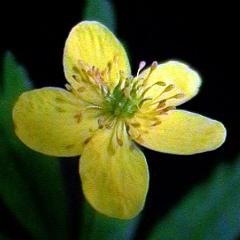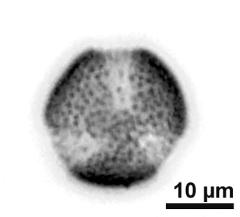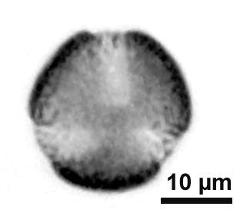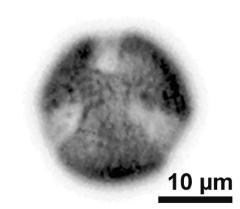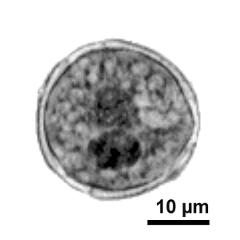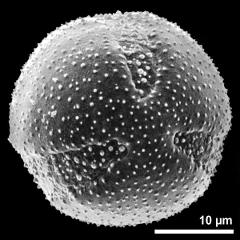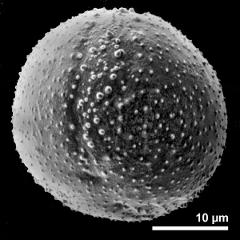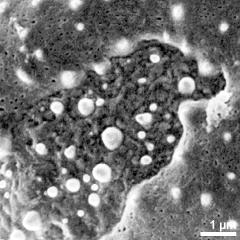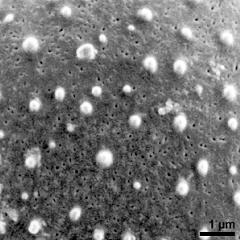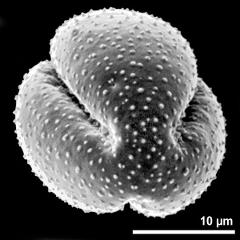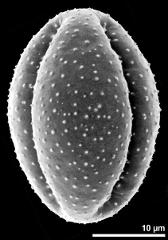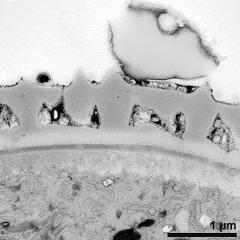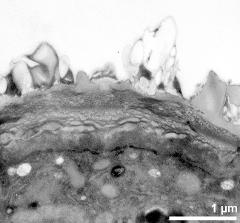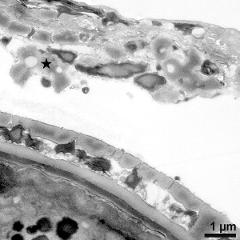Anemone ranunculoides
Taxonomy: Spermatophyta, Ranunculales, Ranunculaceae, Anemone
Published: 2005-06-01
Pollen Description
Shape, Size and Aperture
pollen unit: monad, dispersal unit and peculiarities: monad, size (pollen unit): medium-sized (26-50 µm), size of hydrated pollen (LM): -, shortest polar axis in equatorial view (LM): -, longest polar axis in equatorial view (LM): -, shortest diameter in equatorial or polar view (LM): -, longest diameter in equatorial or polar view (LM): -, pollen class: -, polarity: isopolar, P/E-ratio: -, shape: spheroidal, outline in polar view: circular, dominant orientation (LM): -, P/E-ratio (dry pollen): prolate, shape (dry pollen): -, outline in polar view (dry pollen): lobate, infoldings (dry pollen): aperture(s) sunken, aperture number: 3, aperture type: -, aperture condition: colpate, aperture peculiarities: aperture membrane ornamented
Ornamentation and Structure
LM ornamentation LM: psilate, nexine: -, sexine: -, SEM ornamentation SEM: perforate, microechinate, suprasculpture SEM: -, TEM tectum: eutectate, infratectum: columellate, foot layer: continuous, endexine: compact-continuous, intine: monolayered, wall peculiarities: -, supratectal element: -
Miscellaneous
pollen coatings: pollenkitt, reserves in cytoplasm: lipids, starch, cell number: 2-celled, Ubisch bodies: present
Author(s) of diagnosis: Oberschneider, W.
Pictures
Picture legend
- flower(s), photographer: Oberschneider, W.
- upper focus - fresh, acetolyzed, unstained, photographer: Oberschneider, W.
- optical section - fresh, acetolyzed, unstained, photographer: Oberschneider, W.
- lower focus - fresh, acetolyzed, unstained, photographer: Oberschneider, W.
- generative cell and vegetative nucleus - fixed, formalin-acetic-alcohol, aceto-carmine, photographer: Oberschneider, W.
- polar view - fresh, rehydration (water) & chloroform & critical point dried & sputter coated with gold, photographer: Oberschneider, W.
- equatorial view - fresh, rehydration (water) & chloroform & critical point dried & sputter coated with gold, photographer: Oberschneider, W.
- detail of aperture - fresh, rehydration (water) & chloroform & critical point dried & sputter coated with gold, photographer: Oberschneider, W.
- exine surface - fresh, rehydration (water) & chloroform & critical point dried & sputter coated with gold, photographer: Oberschneider, W.
- polar view of dry pollen grain - dry, sputter coated with gold, photographer: Oberschneider, W.
- dry pollen grain in equatorial view - dry, sputter coated with gold, photographer: Oberschneider, W.
- pollen wall - fresh, glutaraldehyde & osmium & potassium ferrocyanide, modified Thiéry-test, photographer: Oberschneider, W.
- aperture - fresh, glutaraldehyde & osmium & potassium ferrocyanide, uranyl acetate & lead citrate, photographer: Oberschneider, W.
- pollen wall (bottom) and tapetum cells with Ubisch bodies (asterisk) - fresh, glutaraldehyde & osmium & potassium ferrocyanide, uranyl acetate & lead citrate, photographer: Oberschneider, W.
Literature
- (1983) Studies in the pollen morphology of some cultivated Angiosperms Adv Pollen - Spore Res 11: 67 pp, 13 pl, 51 figs
- (1842) Memoir to determine the use of pollen in natural classification. J Bot 1: 575-601
- (1937) European bee plants and their pollen. Bee Kingdom League, Alexandria, Egypt : 164 pp
- (1961) Vegetation and environment in Denmark in the Early Weichselian Glacial (Last Glacial). Dan Geol Unders II: 175 pp, 15 pl
- (1984) A practical pollen guide to the British flora. Quaternary Res Bull Technical Guide I: 1-139
- () Pollenformen und Honigherkunftbestimmung. Bücher des Archivs für Bienenkunde, Berlin 2: 1-122
- (1986) Claves para la determinación de los polenes de las principales especies melíferas de la Península Ibérica. Orsis 2: 27-54
- (1963) Pollini aerodiffusi e le pollinosi. Instituto d'Igiene dell'Universita Palermo : 214 pp
- () Criteri di riconoscimento dei pollini aerodiffusi. Resultati di indagini sul contenuto pollinico dell'aria atmosperica di Palermo. L'Igiene Moderna : 1-27
- (1979) The spore and pollen morphology in relation to the taxonomy and phylogeny of some plant groups. Acta Phytotax Sin 17: 1-8, 3 fig, 3 tabl
- (1987) Taxonomy of Anemone rupicola (Ranunculaceae) and a new species from the Himalayas. Bot Journ USSR 72: 820-826
- (1991) The Northwest European Pollen Flora, 51. Ranunculaceae. Rev Palaeobot Palynol 69: 117-271
- (1942) New Zealand pollen studies. - I. Key to the pollen grains of families and genera in the native flora. Rec Auckland Inst Mus 2: 280-308
- (1877) Pollen. Hardwicke & Bogue, London : 92 pp, 24 pl
- (1952) Pollen morphology and plant taxonomy. Angiosperms. Almquist & Wiksell, Stockholm
- (1954) Pollen morphology and plant taxonomy. Bot Not : 65-81
- (1963) Introduction to Palynology. Natur Och Kultur, Stockholm : 198 pp, 18 pl
- (1961) An introduction to a scandinavian pollen flora. Grana Palynologica 2: 3-92
- (1963) An introduction to a scandinavian pollen flora - II. Almquist & Wiksell, Uppsala : 1-89
- (1964) Text book of pollen analysis. Scandinavian University Books, Munksgaard : 1-237
- (1986) Contribución al conocimiento palinológico de la familia Ranunculaceae en Andalucía. I. Subfam. Helleboroideae. Lagascalia 14: 13-23
- (1987) Aquifoliaceae, Aristolochiaceae, Berberidaceae, Caesalpiniaceae, Cucurbitaceae, Cyperaceae, Fabaceae, Frankeniaceae, Malvaceae, Nymphaeaceae, Paeoniaceae, Plumbaginaceae, Poaceae, Primulaceae, Rafflesiaceae, Ranunculaceae, Rhamnaceae, Santalaceae, Tamaric In: Valdés B., Diez M.J., Fernández I. (eds) Atlas polinico de Andalucia occidental. Inst de Desarrollo Regional 43, Univ de Sevilla
- (1890) Beiträge zur vergleichenden Morphologie der Pollenkörner. Breslau (Thesis) : 1-72
- (1981) Atlas for Mediterranean pollen flora. J Palynol 17: 3-36
- (1832) Beiträge zur Kenntnis des Pollen. Berlin, Stettin und Elbing : 48 pp, 2 pl
- (1985) A review of spiraperturate pollen. Pollen et Spores 27: 307-320
- (1898) A travers les pollens indigènes. Bull Soc Hist Nat Autun 11: 217-238
- (1985) Studies on palynology of some Ranunculaceae from the Garhwal Himalayas. In: Varghese T.M. (ed) Recent Advances in Pollen Research. Allied Publishers : 315-321
- (1955) Contribution à l'étude morphologique des grains de pollen. CR Congr Soc Savantes, Lille, 1955, Sect Sci : 377-389
- (1986) Pollen flora of North-West Himalaya. Indian Association of Palynostratigraphers, Lucknow : 181 pp, 29 pl
- (1897) Beiträge zur Biologie und Morphologie des Pollens. Sitzber Böhm Ges Wiss Prag Jahrb XXIII: 1-76
- (1971) Pollen and Spores of Chile. Univ Arizona Press, Tucson : 1-167
- (1974) The pollen loads of the honeybee. Bee Research Association, London : 150 pp
- (1970) Pollen grains of Formosan plants. VI. Taiwania 15: 73-179
- (1972) Pollen flora of Taiwan. National Taiwan Univ, Botany Dept Press : 297 pp
- (1970) Le pollen et la systématique chez le genre Lysimachia (Primulaceae) - I. Morphologie générale du pollen et palynotaxonomie. Candollea 25: 267-296
- (1970) Pollen and the origin of the Australian Anemones (Ranunculaceae). Bot J Linn Soc 63: 91-93
- (1974) Emploi des données de la morphologie du pollen actuel à l'appui de la théorie de la dérive des continents. Réflexion méthodologiques. Les genres Impatiens et Anemone. Sci Géol Bull, Strasbourg 27: 185-193
- (1970) Le pollen du genre Anemone et du genre Hepatica (Ranunculaceae) et leur taxonomie. Pollen et Spores 12: 329-364
- (1956) Pollen grains of Japan. Hirokawa Publishing Co, Tokyo I-XII: 1-304
- (1988) Pollen: Illustrations and Scanning Electronmicrographs. Kodansha (Tokyo) & Springer-Verlag : 198 pp
- (1940) Bemerkungen u. Beiträge zur Kenntnis der Flora Siebenbürgens und des Banates. Botanikai Közlemenyek 37
- (1991) Palynotaxonomy and phylogeny of Ranunculaceae. Geophytology 21: 207-210
- (1937) Pollen morphology in Ranunculaceae, Lardizabalaceae and Berberidaceae. J Jap Bot 8: 19-46
- (1978) Pollen dicotyledonearum Florae Partis Europaeae USSR. Lamiaceae - Zygophyllaceae. Nauka, Akad Sci USSR, VL Komarov Inst Bot : 184 pp
- (1970) Additional scanning electron photo-micrographs of Southwestern pollen grains. J Arizona Acad Sci 6: 140-161
- (1981) The estimation of evolutionary history with reference to the Berberidaceae. Ph D Diss Univ Mich : 10 pl
- (1981) Surface tension, diffusion and the evolution and morphogenesis of pollen aperture patterns. Pollen et Spores 23: 179-203
- (1970) Études morphopolliniques et des aspects embryologique sur les "Polycarpicae" et Helobiae, avec des considérations phylogénétiques. Lucr Grad bot Bucurest : 3-243
- (1978) On the palynomorphological types of the Armenian Rununculaceae. Biol Zh Armenii 31: 219-222, 5 pl
- (1993) Pollen grains of New Zealand Dicotyledonous Plants. Lincoln NZ: Manaki Whenua Press, New Zealand : 200 pp
- (1834) Über den Bau und die Formen der Pollenkörner. Beiträge zur Anatomie und Physiologie der Gewächse. Erstes Heft. Bern 4: 130 pp, 6 pl
- (1835) Sur la structure et les formes des graines de pollen. Ann Sci Nat, Ser 2 3: 148-180, 220-236, 304-346
- (1978) An illustrated guide to pollen analysis. Hodder & Stoughton Ltd, Kent : 133 pp
- (1976) Flora und palynomorphs of Alaska. Orion Press, Tokyo : 367 pp
- (1965) Pollen grains of Western Himalayan Plants. Asia Monographs, India 1 VIII: 1-102
- (1980) Pollen morphology: the potential influence in higher order systematics. Ann Miss Bot Gard 66: 633-700
- (1983) A palynological study of the genus Helleborus (Ranunculaceae). Grana 22: 129-140
- (1998) Pollenmorphologie der Ranunculanae. Diplomarbeit. Universität Wien : 125 pp
- (1901) Recherches morphologiques sur le pollen des Dialypétales. Journ de Bot : 15-166, 194-204, 218-222, 419-422
- (1968) A morphological characterization of the pollen of some species of the plants of the Amur foreland. Uch Zap Khabarousk Gos Pedagog Inst, Ser Khim - Biol 13: 51-60
- (1981) Palynomorphological characteristics of the Bulgarian representatives of the family Ranunculaceae VII & VIII. Phytology (Bulg Acad Sci) 17: 3-32
- (1980) Palynomorphological characteristics of the Bulgarian representatives of the family Ranunculaceae Juss. V. Phytology (Bulg Acad Sci) 15: 22-61
- (1961) Pollen. Talleres graficos DCP, Gerona
- (1950) Analyse pollinique (Traduction par E. Boltenhagen). Annales du Service d'Information géologique du BRGGM 24: 1-435
- (1937) Cercetari citologice, anatomo - fiziologice si taxonomice la Anemonele din sectio Hepatica. Bul Grad Bot Si Muz Bot Univ Cluj 17
- (1994) Glossary of pollen and spore terminology. LPP Contributions Series, LPP Foundation, Utrecht 1: 71 pp
- (1830) De Cellulis antherarum fibrosis nec non de granorum pollinarium formis: Commentatio phytotomica. Pressburg : 58 pp, 18 tab
- (1980) Late - glacial and Holocene vegetation of Bieszczady Mts. (Polish Eastern Carpathians). Polska Akad Nauk : 202 pp
- (1992) Pollen et spores d'Europe et d'Afrique du Nord. Laboratoire de Botanique historique et Palynologie, Marseille : 520 pp, 446 pl
- (1989) Spores et Pollen. Editions La Duraulié, Cabriés, France : 360 pp
- (1992) Kartoteka Palynologiczna Roslin Polskich. Opolskie Towarzystwo Przyjaciol Nauk, Zeszyty Przyrodnicze 28: 327-336
- (1979) A palynological study of the tribe Ranunculeae. Opera Bot 48: 74 pp
- (1981) Pollen identification for bee keepers. Univ College Cardiff Press : 111 pp
- (1973) Palynomorphs of Japanese plants. Spec Publ Osaka Mus Nat Hist 5: 1-60
- (1986) Cytological studies of Anemone nemorosa L. (Ranunculaceae). Bot J Linn Soc 92: 255-262
- (1964) Pollen morphology of the genus Anemone L. Acta Bot Sinica 12: 19-39
- (1967) Introduction to sporo-pollinique analysis. Publishing House, Nauka, Moscow : 1-270
- (1958) Rapport entre le nombre de chromosomes et la taille des grains de pollen chez les familles arctiques de Ranunculaceae et de Saxifragaceae. Bot Zh Moscow 43: 1146-1155
- (1958) Pollen of the Arctic plants. Nauka, Akad Sci USSR, VL Komarov Inst Bot : 245-292, 24 tabl
- (1976) Kartoteka Palynologiczna Roslin Polskich. Opolskie Towarzystwo Przyjaciol Nauk, Zeszyty Przyrodnicze 16: tabl 224-233
- (1987) Palynological study of the genus Anemone (Ranunculaceae) from Nepal in connection with their systematics. Bot Journ USSR 72: 887-897
- (1962) Recherches palynologiques sur les Renonculacées de la R.P. Roumaine. In: Problème de Biologie. Edit Acad Rep Popul Romine : 79-122
- (1949) Illustration of pollen grains of some Chinese plants. Bot Not 4: 277-282
- (1988) Sobre la palinológia de algunas especies endemicas e interesantes de Andalucia oriental. I. Acta Botánica Malacitana 13: 347-353
- (1980) On the spiraperturate pollen grains. Jap J Palynol 25: 33-47
- (1994) Pollen morphology and its effect on pollen collection by honey bees, Apis mellifera L. (Hymenoptera: Apidae), with special reference to upland cotton, Gossypium hirsutum L. (Malvaceae). Grana 33: 128-138
- (1966) Variation polliniques intraflorales. Adansonia 6: 55-64
- (1967) Pollen et classification. Rev Palaeobot Palynol 3: 65-71
- (1976) Patterns of pollen morphological variation within taxa. Linn Soc Symp 1: 125-137
- (1956) South African pollen grains and spores - Part II. Balkema, Cape Town : 1-132
- (1963) Studies of Indian pollen grains - II. Ranunculaceae. Pollen et Spores 5: 285-296
- (1960) Pollen grains of China. : 276 pp
- (1936) Pollen grains in the identification and classification of plants - VII. Ranunculaceae. Bull Torrey Bot Club 63: 495-514
- (1964) Pollen morphology of the genus Anemone L. Acta Bot Sinica 12: 21-32, 6 pl
Copyright and Citation
Cite this publication as:
Oberschneider W. 2005. Anemone ranunculoides. In: PalDat - A palynological database. https://pc8.botanik.univie.ac.at/pub/Anemone_ranunculoides/110889;jsessionid=70339BC9AB4CB469041E6C9DE3AFA8B4; accessed 2025-07-06

